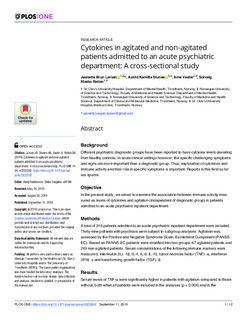| dc.contributor.author | Larsen, Jeanette Brun | |
| dc.contributor.author | Stunes, Astrid Kamilla | |
| dc.contributor.author | Vaaler, Arne | |
| dc.contributor.author | Reitan, Solveig Merete Klæbo | |
| dc.date.accessioned | 2020-02-11T08:39:43Z | |
| dc.date.available | 2020-02-11T08:39:43Z | |
| dc.date.created | 2019-10-04T11:36:26Z | |
| dc.date.issued | 2019 | |
| dc.identifier.issn | 1932-6203 | |
| dc.identifier.uri | http://hdl.handle.net/11250/2640921 | |
| dc.description.abstract | Background:Different psychiatric diagnostic groups have been reported to have cytokine levels deviating from healthy controls. In acute clinical settings however, the specific challenging symptoms and signs are more important than a diagnostic group. Thus, exploration of cytokines and immune activity and their role in specific symptoms is important. Reports in this field so far are sparse. Objective:In the present study, we aimed to examine the association between immune activity measured as levels of cytokines and agitation (independent of diagnostic group) in patients admitted to an acute psychiatric inpatient department. Methods:A total of 316 patients admitted to an acute psychiatric inpatient department were included. Thirty-nine patients with psychosis were subject to subgroup analyses. Agitation was assessed by the Positive and Negative Syndrome Scale, Excitement Component (PANSS-EC). Based on PANNS-EC patients were stratified into two groups: 67 agitated patients and 249 non-agitated patients. Serum concentrations of the following immune markers were measured: interleukin (IL) -1β, IL-4, IL-6, IL-10, tumor necrosis factor (TNF) -α, interferon (IFN) -γ and transforming growth factor (TGF) -β. Results:Serum levels of TNF-α were significantly higher in patients with agitation compared to those without, both when all patients were included in the analyses (p = 0.004) and in the psychosis group (p = 0.027). After correcting for multiple testing, only the findings in the total population remained significant. Conclusions:Our findings suggest an association between TNF-α and agitation in an acute psychiatric population. A similar trend was reproduced to the psychosis subgroup. This suggests that agitation might be an independent entity associated with cytokines across different diagnostic groups. | nb_NO |
| dc.language.iso | eng | nb_NO |
| dc.publisher | Public Library of Science | nb_NO |
| dc.rights | Navngivelse 4.0 Internasjonal | * |
| dc.rights.uri | http://creativecommons.org/licenses/by/4.0/deed.no | * |
| dc.title | Cytokines in agitated and non-agitated patients admitted to an acute psychiatric department: A cross-sectional study | nb_NO |
| dc.type | Journal article | nb_NO |
| dc.type | Peer reviewed | nb_NO |
| dc.description.version | publishedVersion | nb_NO |
| dc.source.volume | 14 | nb_NO |
| dc.source.journal | PLOS ONE | nb_NO |
| dc.source.issue | 9 | nb_NO |
| dc.identifier.doi | 10.1371/journal.pone.0222242 | |
| dc.identifier.cristin | 1733884 | |
| dc.description.localcode | ©2019Larsenet al. This is an openaccessarticledistributedunderthe termsof theCreativeCommonsAttributionLicense,whichpermitsunrestricted use, distribution, andreproductionin any medium,providedthe originalauthorand sourceare credited. | nb_NO |
| cristin.unitcode | 1920,20,0,0 | |
| cristin.unitcode | 194,65,35,0 | |
| cristin.unitcode | 1920,15,0,0 | |
| cristin.unitcode | 194,65,15,0 | |
| cristin.unitname | PH - Divisjonsstab Psykisk Helsevern | |
| cristin.unitname | Institutt for psykisk helse | |
| cristin.unitname | Medisinsk klinikk | |
| cristin.unitname | Institutt for klinisk og molekylær medisin | |
| cristin.ispublished | true | |
| cristin.fulltext | original | |
| cristin.qualitycode | 1 | |

